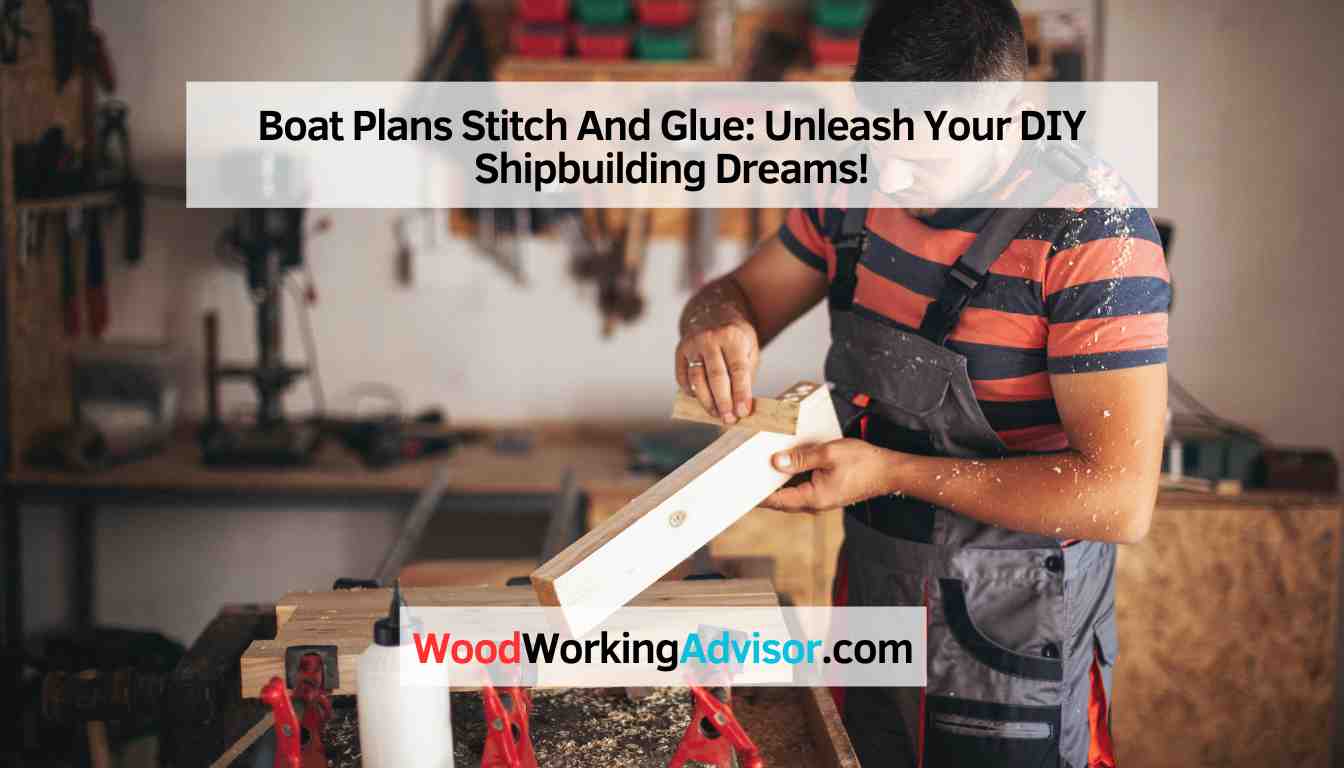Boat plans stitch and glue are easy to follow for building small boats efficiently. These plans use plywood panels and fiberglass tape for construction.
Stitch and glue boat building is a popular method among DIY boat builders due to its simplicity and cost-effectiveness. By utilizing plywood panels and epoxy resin to stitch pieces together, boat enthusiasts can create sturdy vessels without the need for intricate woodworking skills or expensive tools.
Whether you are a beginner looking to embark on your first boat-building project or an experienced craftsman seeking a quick and efficient build, stitch and glue boat plans offer a straightforward and rewarding process. We will explore the intricacies of boat plans stitch and glue and how you can get started on your own boat-building journey.
The Basics Of Stitch And Glue Boat Building
Before delving into the fascinating world of stitch and glue boat building, let’s explore the fundamental concepts behind this method. Stitch and glue, a modern boat building technique, is renowned for its simplicity and ease of construction, making it an attractive option for both beginners and seasoned builders alike.
The Origins Of Stitch And Glue
Stitch and Glue originated in the mid-20th century as a response to the complexities of traditional boat building methods. This innovative approach involves stitching together pre-cut panels of plywood and then gluing them with epoxy resin, creating a durable and lightweight boat structure.
Key Features Of Stitch And Glue Method
- Simplicity: Stitch and glue technique requires minimal tools and woodworking skills, making it accessible to novice builders.
- Flexibility: Builders can easily customize designs and make modifications during the construction process.
- Cost-Effective: Stitch and glue boats are often cheaper to build compared to traditional wooden boats.
| Feature | Description |
|---|---|
| Fast Construction | Due to its simple assembly process, stitch and glue boats can be built quickly. |
| Lightweight Structure | The use of plywood and epoxy results in lightweight yet sturdy boat hulls. |
Embracing the stitch and glue method opens up a world of possibilities for aspiring boat builders, combining efficiency with creativity to craft seaworthy vessels with your own hands.
Tools And Materials Needed
When embarking on a stitch and glue boat building project, having the right tools and materials is essential. Here is a look at the tools and materials you will need to get started:
Essential Tools For Stitch And Glue Boat Building
- Saw
- Clamps
- Drill
- Sanding Block
- Measuring Tape
- Paint Brushes
Key Materials For Stitch And Glue Boat Construction
- Marine Grade Plywood
- Epoxy Resin
- Fiberglass Cloth
- Copper Wire
- Filler Putty
- Paint or Varnish
Choosing The Right Boat Plans
Choosing the right boat plans is crucial for a successful Stitch and Glue boatbuilding project. It’s essential to consider several factors when selecting the ideal boat plans to ensure that they meet your specific requirements and skill level.
Factors To Consider When Selecting Boat Plans
1. Skill Level: Consider your level of expertise in boatbuilding and choose plans that match your skills, from beginner-friendly designs to more advanced options.
2. Boat Size: Determine the size of the boat you want to build, whether it’s a small dinghy or a larger vessel, and find plans that align with your desired dimensions.
3. Purpose: Identify the intended use of the boat, such as recreational sailing, fishing, or cruising, and select plans designed for your specific needs.
4. Material Availability: Consider the availability of materials in your area and choose plans that utilize readily accessible materials to avoid logistical challenges.
Popular Stitch And Glue Boat Designs
Stitch and Glue boatbuilding has gained popularity due to its simplicity and versatility, offering a range of popular designs for enthusiasts to choose from:
- Pirogue: A traditional, versatile, and easy-to-build boat often used for fishing and recreational activities.
- Kayak: Ideal for solo paddling and exploring narrow waterways, available in various sizes and designs.
- Canoes: Ranging from simple solo canoes to larger tandem models, offering versatility for different water conditions.
By considering these factors and exploring popular designs, you can ensure that the chosen boat plans align with your skills and preferences, setting the stage for a rewarding Stitch and Glue boatbuilding experience.

Credit: www.amazon.com
Step-by-step Construction Process
Discover the step-by-step construction process for boat plans Stitch and Glue, guiding enthusiasts through the process of building their own boat using this popular method. With detailed instructions and illustrations, this guide ensures a smooth and successful construction experience.
Preparing The Work Area
Before you begin the construction process of your stitch and glue boat, it is important to prepare your work area. By taking the time to organize and set up your space properly, you can ensure a smooth and efficient building experience.
To start, find a clean and well-ventilated area that is free from any clutter or obstacles. This will allow you to move around freely and safely as you work on your boat. Make sure you have enough space to lay out your boat plans and materials without any restrictions.
Next, gather all the necessary tools and materials you will need for the construction process. This may include plywood sheets, epoxy resin, fiberglass cloth, a jigsaw, clamps, sandpaper, and a paintbrush. Having everything readily available will save you time and prevent unnecessary interruptions.
Create a comfortable and ergonomic work setup by using a sturdy workbench or table. Set up a bright and easily adjustable task light to ensure you have proper visibility during the construction process. Additionally, consider using a non-slip mat or work surface to prevent accidents and provide stability for your materials.
By preparing your work area in advance, you can set yourself up for success and make the construction process smoother and more enjoyable.
Stitching, Gluing, And Finishing The Boat
Once your work area is ready, you can dive into the exciting process of stitching, gluing, and finishing your stitch and glue boat. This careful and precise process will bring your boat plans to life, resulting in a beautiful and functional watercraft.
Start by carefully cutting out the plywood pieces according to the dimensions specified in the boat plans. Ensure each piece is accurately cut to fit together seamlessly. Use a jigsaw or similar tool to achieve clean and precise cuts.
Next, it’s time to stitch the boat together. Lay out the plywood pieces on your work surface and use copper wire or zip ties to temporarily hold them in place. This stitching stage allows you to adjust and align the pieces before applying epoxy resin.
Using a brush or roller, apply a thin layer of epoxy resin to both sides of the joints between the plywood pieces. Ensure an even and thorough coating to create a strong bond. Allow the epoxy resin to cure according to the manufacturer’s instructions.
Once the epoxy resin has cured, remove the temporary stitching and reinforce the joints with fiberglass tape or cloth. Apply additional epoxy resin to secure the fiberglass and create a watertight seal. Sand down any rough edges or imperfections for a smooth finish.
Finally, it’s time to add the finishing touches to your stitch and glue boat. This may include painting the exterior, varnishing the interior, or adding hardware such as oar locks or cleats. Allow ample time for the paint or varnish to dry before launching your boat into the water.
By following these step-by-step guidelines, you can confidently construct your stitch and glue boat, knowing that you have successfully stitched, glued, and finished it to perfection.
Tips For A Successful Diy Boat Building Project
Embarking on a DIY boat building project can be a rewarding and fulfilling endeavor. Building your own boat from scratch allows for customization and a sense of accomplishment. While it may seem like a daunting task, with proper planning and the right boat plans like stitch and glue, you can create a beautiful and functional boat.
Avoiding Common Mistakes
When starting a DIY boat building project, it’s important to be aware of common mistakes that can hinder the progress and success of your build. By avoiding these mistakes, you can save time, money, and frustration.
- Ensure you have the necessary skills and knowledge before diving into the project. If you’re a beginner, start with a simpler design and gradually work your way up to more complex boat plans.
- Take the time to accurately measure and cut your materials. A small mistake in measurements can have a significant impact on the final result.
- Pay attention to detail and follow the instructions provided with the boat plans carefully. Skipping steps or taking shortcuts can lead to structural weaknesses and problems down the line.
- Regularly check and double-check your work as you progress. It’s easier to fix any issues or errors early on rather than waiting until the later stages of the project.
- Stay organized and keep your workspace clean. Clutter and disorganization can make it difficult to find tools and materials when you need them.
Ensuring Safety And Quality In The Build
When building your DIY boat, safety should be a top priority. Additionally, ensuring a high level of quality in the construction will result in a boat that is not only aesthetically pleasing but also safe to use on the water.
- Always wear appropriate safety gear, such as safety glasses and gloves, when working with tools and materials.
- Use the right materials for the job and make sure they are of good quality. This will ensure the structural integrity and longevity of your boat.
- Follow proper safety procedures when using power tools and equipment. Familiarize yourself with their operation and maintain them regularly.
- Consider consulting with experts or experienced boat builders if you’re unsure about certain aspects of the project. Their guidance can help you avoid costly mistakes and ensure a safe build.
- Test your boat for buoyancy and stability before taking it out on the water. This will give you peace of mind and ensure that your boat is capable of handling the conditions it will encounter.

Credit: www.powerandmotoryacht.com
Frequently Asked Questions On Boat Plans Stitch And Glue
What Are Stitch And Glue Boat Plans?
Stitch and glue boat plans are a popular construction method for small boats, using plywood panels that are held together with wire stitches and then glued with epoxy. This technique allows for easy construction without the need for complex woodworking skills.
Are Stitch And Glue Boats Safe?
Yes, stitch and glue boats are safe when built properly using high-quality materials. The stitching and gluing technique provides strong joints and ensures the boat is able to withstand the forces of the water. However, it is important to follow the plans and instructions carefully to ensure a safe and seaworthy vessel.
How Long Does It Take To Build A Stitch And Glue Boat?
The time it takes to build a stitch and glue boat depends on the size and complexity of the design, as well as your level of experience and available time. Smaller boats can be completed in a matter of weeks, while larger and more intricate designs may take several months to finish.
Conclusion
Boat plans stitch and glue method offers simplicity and efficiency in building a boat. With its user-friendly approach, even beginners can create sturdy and reliable watercraft. By following the step-by-step instructions, anyone can master the art of boat building. Explore the possibilities and set sail with confidence!


